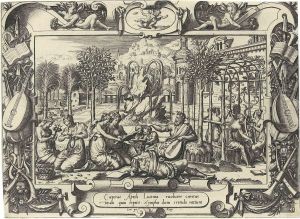Francois Langlois Paintings
François Langlois, also known by his Italianized name Francesco Langus or Il Ciartres, was a French draftsman, printmaker, publisher, and art dealer who made significant contributions to the art world during the first half of the 17th century. Born in Chartres, France, in 1589, Langlois was not only involved in the production and distribution of prints but also played a role in the dissemination of the Italian Baroque style in France. His activities helped to shape the taste of the French art market and influenced the work of local artists.
Langlois initially trained as an engraver and was particularly influenced by the work of the Italian artist Antonio Tempesta. His travels to Italy early in his career were crucial for his development; he spent time in Rome, which was a hub for artists and intellectuals during that period. There, he absorbed the dynamic styles and techniques of the Italian masters, which he would later introduce to the French audience.
Returning to France, Langlois settled in Paris, where he became a central figure in the art trade. He dealt not only in prints but also in paintings, drawings, and other artworks. Langlois was known for his eclectic taste and his ability to cater to the preferences of his clients, ranging from collectors to members of the French court. His shop became a gathering place for artists and connoisseurs, fostering a lively cultural exchange. Langlois was also noted for his own collection of art, which included works by prominent Italian and Northern European artists.
Moreover, Langlois contributed to the art world through his work as a print publisher. He reproduced the works of well-known artists such as Jacques Callot, Stefano della Bella, and Nicolas Poussin, thereby helping to spread their styles and compositions. His efforts in publishing and dealing with prints played a significant role in the evolution of printmaking in France.
François Langlois's activities extended beyond the realm of visual arts. He was also a musician and had an interest in musical instruments, which he collected and sold. His multifaceted engagement with the arts reflected the interconnected nature of cultural pursuits at the time.
Langlois passed away in 1647, leaving behind a legacy that highlighted the importance of cultural exchange and the dissemination of artistic styles across Europe. His work as a mediator between Italian and French art had a lasting impact on the evolution of French art in the 17th century, contributing to the dialogue between the Baroque movement and French classicism.
